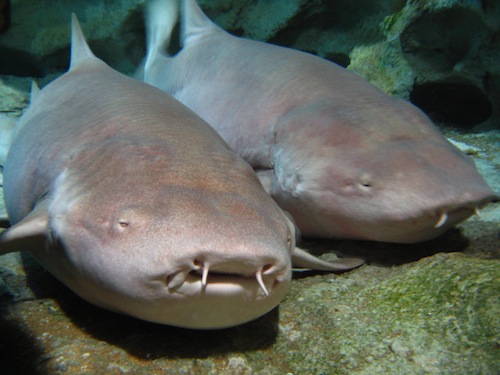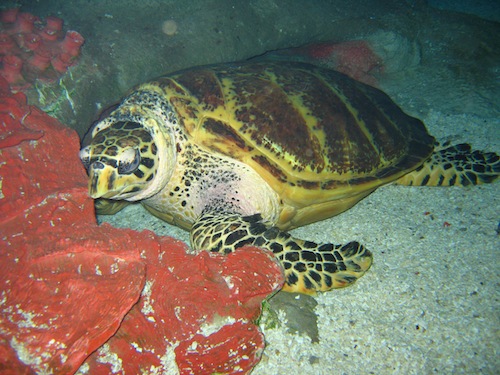
I’d seen SinoScuba’s event listings floating around the beijingkids website for a while now, but never actually took the plunge – until last weekend. I’d tried getting in touch with Founder Steven Schwankert a couple of times before, but we never managed to settle on a date. When he recently came onboard as the Beijinger’s new managing editor (yes, we work together now), I cornered him for a scuba diving lesson. As it turned out, he had open slots for SinoScuba’s Shark Interaction Program at Blue Zoo Beijing last Sunday. My little sister was visiting from Shanghai for the weekend, so I signed us both up.
We met Steven at the entrance of Blue Zoo Beijing at 1.30pm. He took us into the bowels of the aquarium – a restricted area beneath the man-made lake by the Worker’s Stadium. We started off with a tour of the shark nursery; we saw pouch-shaped cat shark eggs, tiny shark pups, mean-looking snapping turtles, and a big yellow leopard shark. My sister and I “awwwed” at the albino cat sharks that didn’t know they were albino cat sharks and persisted in hiding against the dark tank walls.
Then, we received a basic safety lesson and an intro to the scuba diving equipment. My sister and I eyed the wetsuits skeptically and wondered how we we’d be able to pour ourselves into the narrow outfits. Sure enough, we heaved and hauled and molded our unwilling flesh into the neoprene wonders; some of Blue Zoo Beijing’s mermaids, who were on break at the time, watched our locker room acrobatics with a smile.
Red-faced, we penguin-walked back out to the area with the nursery tanks. We entered the adjacent room, which opened onto the actual aquarium. We could see outlines of sharks, fish, and eels in the blue waters below. One by one, we sat on a ledge and put on our equipment: diving mask, flippers, diving vest with weights, regulator, tank – the whole kit. We inflated our vests. After some last words on hand signals, we followed Steven into the water and sank to the bottom of the aquarium.

It’s hard to do justice to that first dive. Everything was so clear; we could see parrot fish circling the coral, sharks gliding above us, and spotted moral eels lurking from crevasses. The ability to breathe underwater and the weightlessness of our bodies created an incredibly liberating experience. We were mildly alarmed by all the sharks circling the tank, but realized pretty quickly that they couldn’t care less about their human visitors.
Steven led us around the tank and pointed out interesting sights, signaling when it was OK to touch something. We came across a huge sea turtle taking a snooze in a corner; its shell was coarse to the touch. We petted two fat, complacent sharks snuggling in the dark; Steven indicated that we could try petting both simultaneously, but that didn’t quite work out because of my lop-sided swimming.
The manta rays were separated from the shark tank by a pane of glass containing finger-sized holes in the top. They came to investigate us, their white undersides glancing against the glass; we poked our fingers through the openings and felt their soft underbellies as they passed by.
We also “showered” fish by gathering sand in our hands and letting it slip through our fingers; the fish gathered under the cascade and seemed to enjoy the feeling of the sand on their backs. I imagined them uttering the same sound that Homer Simpson does when he’s eating a doughnut.
It wasn’t all smooth. At some point, I followed the wrong guy (there were other scuba divers) and got lost. I hung out by the fake shipwreck until Steven and my sister found me. A few minutes later, I head butted a shark with an audible “thud” (or so it seemed); I’m sure the onlookers got some good photos. As soon as we surfaced, my sister said: “Did you…?” I cut her off: “Yes. Yes, I did.”

Overall, it was a fantastic experience. Hours later at Great Leap, we were still excitedly discussing the minutiae of scuba diving and the feasibility of getting our respective PADI certifications. We had grand visions of the Chen sisters taking off to the Grand Barrier Reef or the Cayman Islands on some underwater adventure.
Steven himself was a patient instructor who gave clear instructions and checked in often with his students. SinoScuba accepts participants aged 10 and up for its programs; the Shark Interaction Program costs RMB 650 per adult (RMB 600 per child) and happens regularly at Blue Zoo Beijing. There’s also the upcoming Shark Weekend 2013 on August 3 and 4. Reservations are a must at all times, since there’s a maximum of four divers per session. If you’re currently considering diving with SinoScuba, consider no more; just go for it.
To find out more about SinoScuba, visit their website. Contact Steven at steven@sinoscuba.com or 186 1113 3629.
Photos courtesy of Steven Schwankert



